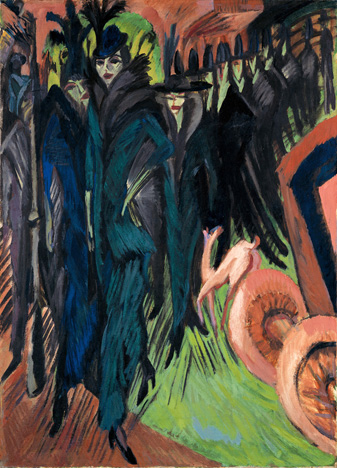Tuesday, April 6, 2010
Critique #3
“Street Scene” is a painting done by Ernst Ludwig Kirchner that relates to my concept of conformity. In this piece of artwork painted in 1914, there is a confident-looking woman posing, followed by a long line of people without identifiable faces or characteristics. To either side of this woman is another woman, both with distinct facial expressions. Out of everyone in the painting, the three women in the front of the line are the only ones with noticeable faces.
Most of the colors used in the painting are dark and dim. Dim shades of blue, pink, black and purple can be seen. However, light green and pink are also used in the street and on the small dog by the line, and those colors contrast with all the other dark shades of color. Most of the bright colors can be found at the front of the painting, creating emphasis on the area closest to the viewer. Also, the bright green found on the men’s outfits creates chiaroscuro with the rest of the figures’ outfits, since there’s a sharp distinction between the two colors. The foreground of the painting is clearly the confident woman in the dark teal outfit. The confident looking woman is placed between the two other women with faces, creating juxtaposition. The field behind the three women consists of a line of men that seems to stretch on indefinitely. The texture of the women’s clothing makes the outfits seem soft and feathery. Based on the positions of all of the feet, the figures in the painting all seem to be moving forward. The line is formed at a weird angle, like the people are trying to avoid the carriage near the front of the painting. There is no consistent plane, since the areas in the painting do not appear to be flat, and some parts seem to curve upwards.
The focal point of the painting is the three women found at the beginning of the long line. They are the only ones with distinct expressions and outfits. It seems like the line of figures in back of the women is following them. This might be because of their sharp characteristics and their confidence, and the line could represent that the figures are following the women’s example. This shows conformity because instead of creating their own person, every person in the line of figures is following the women’s example and acting like them.
Subscribe to:
Posts (Atom)
